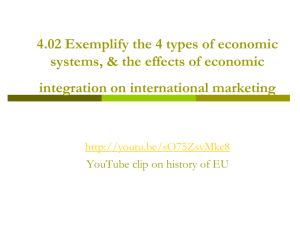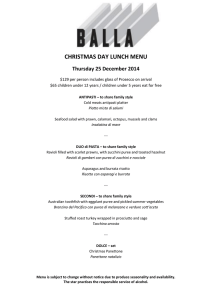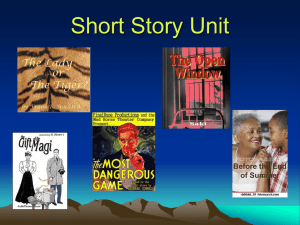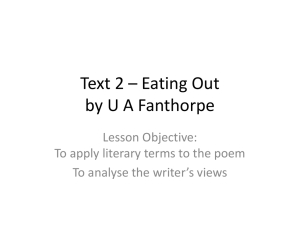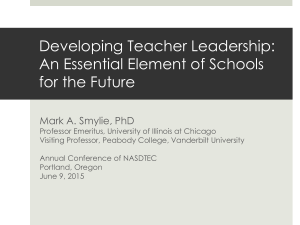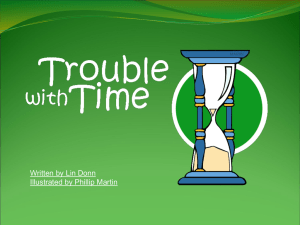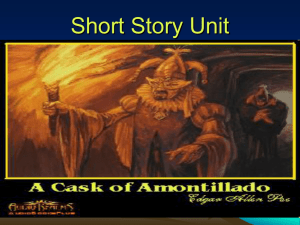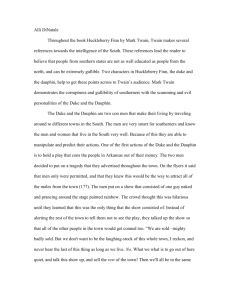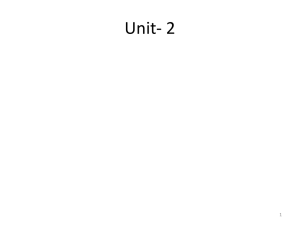The Review of Knulp
advertisement
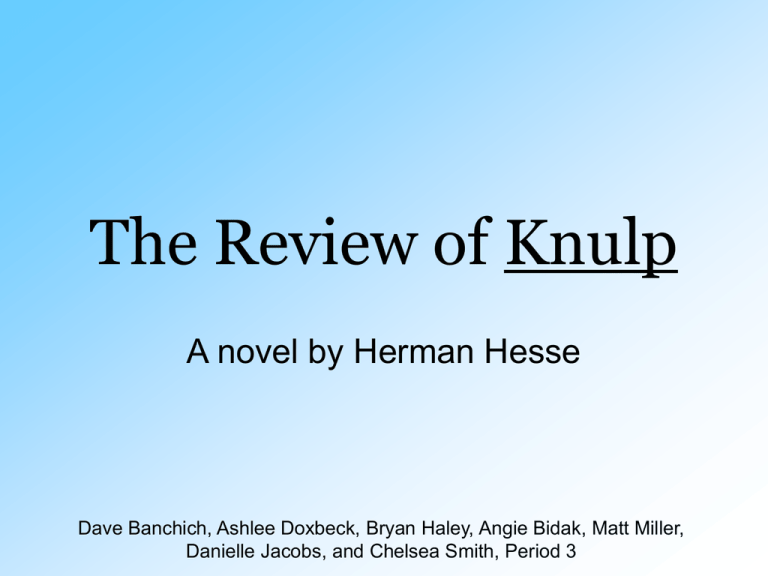
The Review of Knulp A novel by Herman Hesse Dave Banchich, Ashlee Doxbeck, Bryan Haley, Angie Bidak, Matt Miller, Danielle Jacobs, and Chelsea Smith, Period 3 Description of Setting • The time period of Knulp is continuously throughout the 1890’s • It is located mainly in Central Germany, Lachstetten Plot Summary – Early Spring • Knulp’s only specific profession is that of a tramp and a traveler. One day, he feels feverish and he decides to check in with an old friend by the name of Emil Rothfuss. Knulp is received as an honored guest and invited to stay for as long as he wants. • Knulp wanders the town with no real direction, but stops in to visit old friends or chat with other journeymen. Within a few days, Knulp also takes notice of the young maid next door and decides to catch her attention. He invited Barbele out for dancing one night and they leave each other with a kiss, and she leaves him with a coin. Plot Summary – My Recollections • The narrator dicusses a summer spent with Knulp. He describes Knulp’s many talents for entertaining and socializing. He recalls one specific one specific time when Knulp led him into a graveyard, where they discussed life, love, and friendship. Knulp discusses his former relations with a girl named Lisabeth, a story which gives insight into his character. • Later on, the two go to a bar together for dinner. The narrator orders drinks while Knulp hesitates. Knulp soon leaves, and his friend stays. Knulp is not heard from again. Plot Summary – The End • A traveler recognizes Knulp walking along the road. He remembers him as a classmate. The traveler is a doctor and notices Knulp is ill and so he insists that Knulp come with him to be cared for. • The doctor has a long talk with Knulp about his past which explains much about the character that Kunlp has turned out to be. His story deals with unrequited love, which changed his entire life. • The doctor sees Knulp get weaker by day, and arranges for a hospital stay. Knulp agrees but then leaves on his own once more. His life flashes before his eyes. He imagines talking to God about his life purpose. Knulp dies, laying in the Snow. Character Summary • Knulp: Knulp is an amiable vagabond with a unique outlook on life. His only profession is that of a tramp but his road book is organized and he stays out of trouble. He is somewhat famous for occupying such a strange, dutiless existence. Outwardly he appears young and handsome, with a certain gracefulness in his movements. Knulp is pleasant, polite, and a smooth talker, and so easily makes good friends who show him hospitality. Despite his qualities as a people person, he is extremely independent. He has several seemingly useless talents, such as song and poetry writing which display his unique philosophies. Main Conflict • The main conflict found in Knulp is that of person vs. self. This can be found in the way in which Knulp questions his purpose in life towards the end of the story. Throughout the story, the way in which Knulp lives a nomadic life of freedom is shown to come in direct conflict with him finding purpose in life. This can be seen of course by when the work book with many stamps is discussed, or the way in which Knulp just moves on. • Also, the conflict can be seen even more when we see how Knulp will end a conversation about philosophy, principle, and the meaning of life quite abruptly. This shows that Knulp may not want to talk about the meaning of life because he is unsure about his meaning. Main Conflict Con’t • However the part where we see the conflict the clearest is at the end of the story. It is here that we see Knulp return to his home town as if he is returning in a last ditch attempt to find meaning within his life at the place where it all started. However, he continues to hold himself back here still and be his own greatest adversary when he lingers outside the town for the last bit of the story instead of venturing in and confronting himself and his past. Main Conflict Con’t • Throughout the story, Hesse leaves hints of Knulp’s intentions or goals in the conflict. From his world weary demeanor in the first chapter to his discussions with the narrator in the middle and the way in which he questions whether he lived a good life or not at the end. All of these instances serve to show that Knulp merely wants to find meaning in a life in which he feels full of emptiness. Resolution of Conflict • The conflict in Knulp comes to an end with Knulp’s discussion about his life with God. Whether this discussion is merely a delusion created by Knulp’s sickness, or actually a discussion with God at the end of his life isn’t important. However, the discussion itself, about whether Knulp lived a good life or not, was. Knulp acts as the antagonist by saying he could have done something differently such as staying in school or finding direction in life. Resolution Con’t • Versus “God” acting as the antagonist by saying there was meaning in all the good times and wandering that Knulp had, and that he brought happiness to many people and gave them hope. He “settled their homesickness for freedom.” In this way, Knulp’s battle to find meaning in life is resolved in that he lived a life of freedom so that other people could live that way through him and experience it almost as a child. It’s then by this resolution that Knulp is able to move on to death in peace and contentment with his existence. Quotations • “Knulp looked at me closely; then his black lashes flickered and he said thoughtfully, “Yes. But that comes to an end too, like everything else. All sorts of things can wreck a friendship, or a love for that matter.” Page 56. • Knulp is not stressing the importance of love or sympathy towards the tanner. He is just stating that everything amounts to nothing. Quotations Con’t • “In the end, we all have a life of our own that we can’t share with everyone else. You can see that when a friend or loved one dies, you weep and grieve for a day, a month, or even a year, but then the dear departed is dead and gone and the person in the coffin might as well be some helpless unknown apprentice.” • Rolling over the presence of death but not sharing any empathy for those who grieve for those who’ve died. Literary Elements • Symbolism. The symbols represent solitude, loneliness, and human kind’s singular destiny. • “Their souls are like flowers, each rooted to its place. One can’t go to another because it would have to break away from its roots… A flower can’t do anything to make a seed go to its right place; the wind does that and the wind comes and goes when it pleases. Literary Elements Con’t • These passages symbolize the solitudinous human soul and the loneliness felt by Knulp, as humans all have their own unique destiny that is shaped by fate. Literary Elements Con’t • “After a few days of being alone he say the town down below, the sounds that rose up to him were alien and hostile, and he knew the town was no longer his place… He spent the night in wood cutters’ cabins or in the fields bedded in straw.” Major Themes • Identity: Knulp struggles throughout his life in a quest for identity and self understanding. • Self-Fulfillment: Knulp learns that only he can control most of his life, and he cannot blame all of his problems on the actions of others. Characters Support Theme • Knulp experiments with Catholicism by attending services and studying the Bible and eventually rejects it to search for his own unique way of life. • At the close of the last story, Knulp recalls his experiences with young love and his painful feelings that came over him when he was rejected by the first female in his romantic life. He realized that in these later years, only he can cope with these feelings. • Knulp experiments with various careers, such as blacksmith and none seem to meet his personal standards. This is one of the ways in which he searches for a sense or identity.




